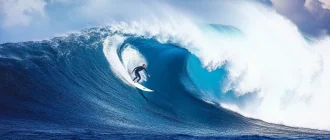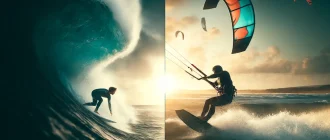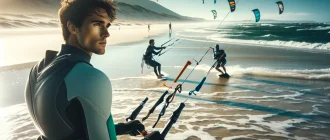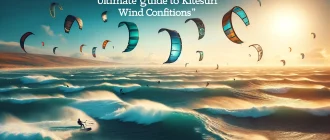Are you deciding between Kitesurfing vs Windsurfing? This article directly compares thrill factors, essential gear, learning journeys, and fitness needs to guide you. Discover which adrenaline-fueled sport suits your lifestyle, aspirations, and local winds and waves.
Key Takeaways
- Windsurfing and kitesurfing utilize wind differently, with windsurfing attaching the sail to the board and using a separate kite, resulting in distinct experiences of either riding waves or experiencing flight-like sensations.
- Both sports offer a full-body workout but differ in physical demand, with windsurfing focusing on the upper body and core strength. At the same time, kitesurfing requires a strong core for control and less overall physical strain.
- Transporting gear to your water sports location needs consideration; windsurfing equipment is typically more extensive and less portable, possibly requiring a roof rack, while kitesurfing gear is more compact and can fit inside most cars.
The Essential Distinctions of Kitesurfing and Windsurfing
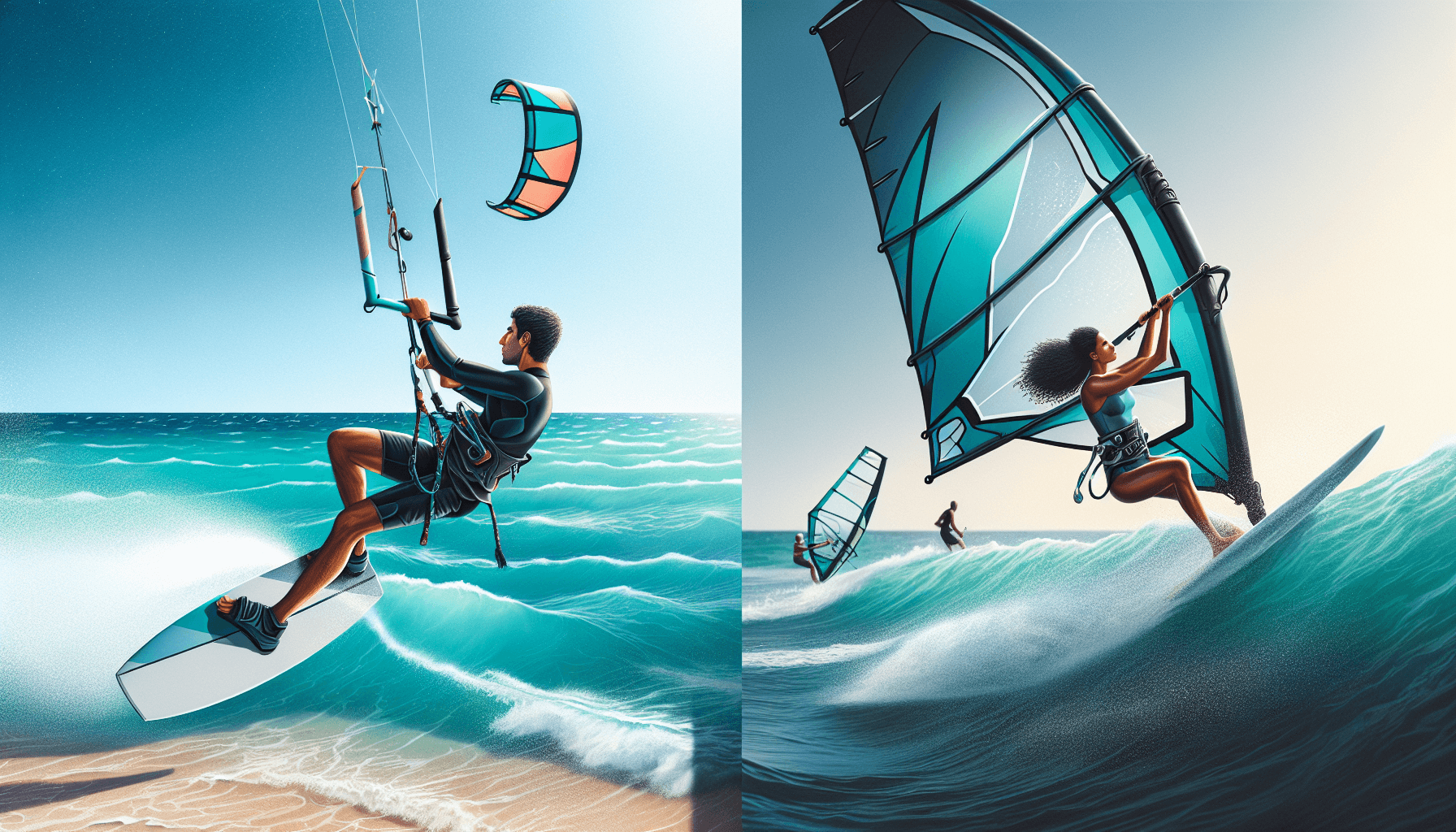
Windsurfing and kitesurfing might appear similar at a glance, both being wind-driven water sports. However, the differences between the two are significant, affecting every aspect, from the learning process to the level of thrill during the ride. The main differences lie in how each sport harnesses the wind, the board’s dynamics, and the ride’s unique feel.
In windsurfing, also known as wave sailing, the wind powers a large sail attached to a board, requiring proficiency in maneuvering both wind and waves for control. The windsurfer directly manipulates the sail with every gust and shift in wind direction felt through the hands.
Imagine a sport that allows you not only to ride the waves but to soar above them as well! This is kite surfing, where a large kite, unattached to the board, harnesses the power of the wind. As a kite surfer, kitesurfing requires managing the kite lines, and the feel of the ride is more about the interplay between the trainer kite, the strong wind, and your body.
Your preferences and circumstances will likely determine whether you choose windsurfing or kitesurfing. Are you intrigued by the art of catching the wind in a big sail and gliding across the water’s surface, or does the idea of harnessing the wind’s power in a kite to perform gravity-defying jumps and tricks excite you? Remember that your physical condition, the learning curve, and location can affect this decision.
Regardless of your choice, you will experience fun, excitement, and a healthy dose of adrenaline!
Harnessing the Wind: Sails vs Kites
Wind, the unseen force powering both windsurfing and kitesurfing, is crucial to discuss. In windsurfing, you directly control the sail attached to the board using a boom and mast. This direct control requires physical strength and technique, significantly affecting navigation and movement on the water. The sail is your connection to the wind, and harnessing the wind’s power directly can be incredibly exhilarating.
However, you’re handling a kite that functions much like a parachute in kitesurfing. The kite isn’t attached to the board, giving you a different kind of control and experience. The kite becomes your link to the wind, and its manipulation demands a different skill. The kite’s design allows for more dynamic movement, including quick direction changes and performing aerial tricks.
The distinct ways these sports harness the wind fundamentally alter the experience. You’re more connected to the water surface in windsurfing, feeling each wave through the board. In contrast, kitesurfing offers a sensation of flight, with the kite capable of lifting you off the water and into the air. So, do you prefer skimming the water’s surface or soaring above it? The choice is yours!
Board Dynamics: Long Boards vs Short Boards
Having discussed the learn windsurfing aspect, let’s move on to the boards – what you’ll be standing on. In windsurfing, the board is a crucial component. It’s part of the sail rig, requiring balance and skill for steering and managing it in various water conditions.
Windsurfing boards come in different types, such as longboards, which perform well in light wind and are used in racing, and shortboards, which are better for high wind and wave conditions. The board’s size and design, especially the presence of a daggerboard, contribute to its excellent stability, which can benefit beginners.
Kitesurfing boards, on the other hand, are typically:
- smaller and more maneuverable compared to windsurfing boards
- allow for more dynamic moves, including jumps and tricks
- can be a bit more challenging for beginners to maintain balance.
Your experience can be significantly influenced by the type of board you choose. If you love carving through waves and feeling the water under your feet, a windsurfing board might be your choice.
If you’re drawn to maneuverability and the potential for high-flying tricks, a kitesurfing board could be more your style.
The Feel of the Ride: Wave Riding vs Flat Water Gliding
The excitement of windsurfing and kitesurfing extends beyond wind and boards; it encompasses the unique feelings and experiences each sport provides. In windsurfing, you have a tactile connection with the water as you carve through waves, delivering a robust sensation of engaging with natural elements. You can feel each wave, current, and the wind’s shift, connecting you directly to nature.
In contrast, kitesurfing delivers a unique sensation of flight, where riders can:
- be lifted into the air by the kite, contrasting the more surf-like experience of windsurfing
- skim the water’s surface
- with a strong gust of wind, find themselves flying through the air
The dynamics of your ride are more defined by how the kite interacts with the wind rather than how the board interacts with the water.
Whether you prefer the tactile experience of wave riding or the airborne thrill of flat water gliding, both options are part of the exciting world of water sports. One thing’s for sure: both sports offer a fantastic way to connect with nature, harnessing the power of the wind to deliver a unique and exhilarating experience.
Gear Examination: Windsurfing Equipment vs Kitesurfing Kit
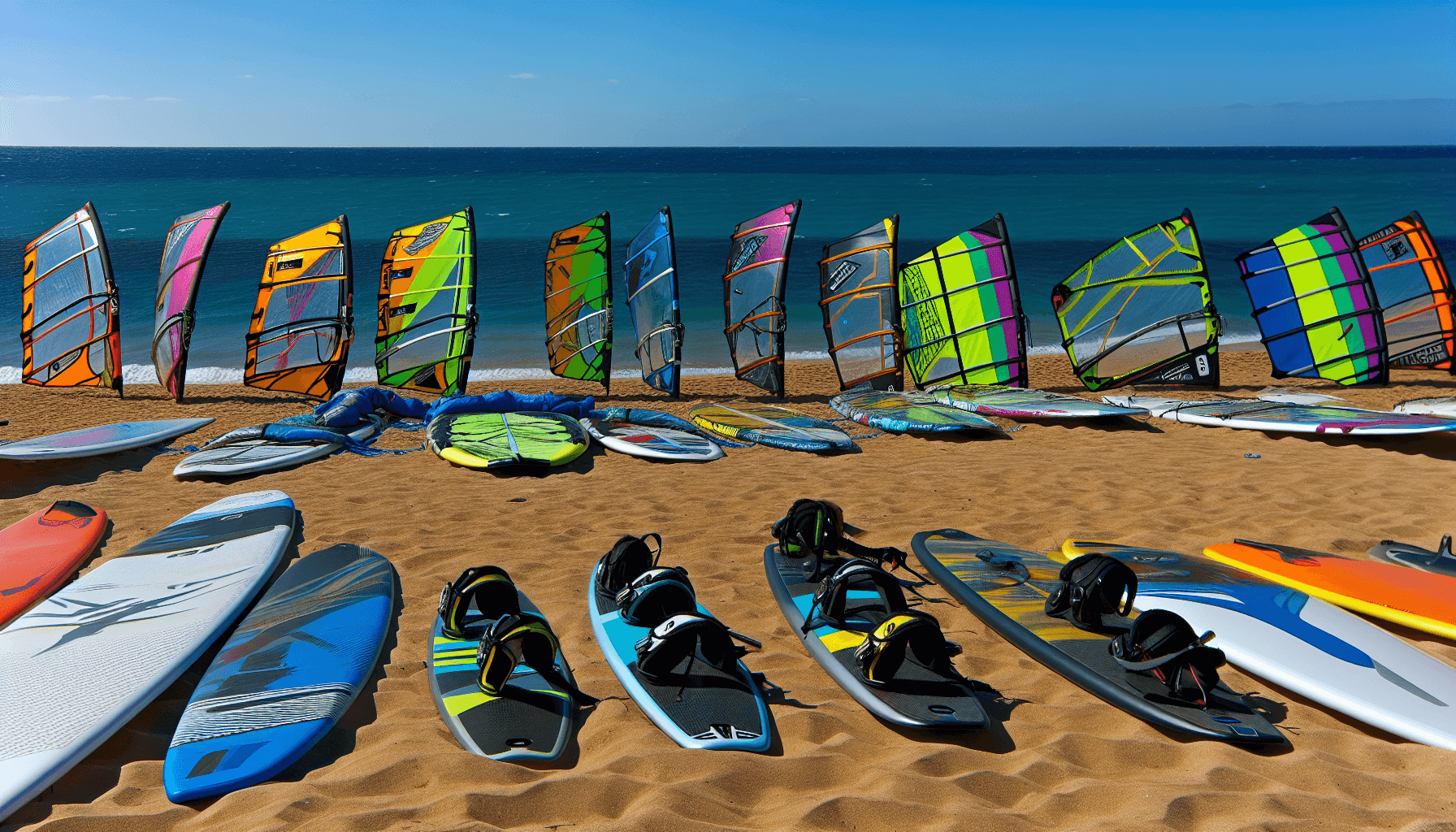
Similar to how the experiences of windsurfing and kitesurfing vary, the equipment used in each sport also differs. While both sports harness the wind to propel a sail, the equipment varies substantially, impacting everything from performance to user experience.
In windsurfing, the sail is directly attached to the board, allowing the rider to control both the sail and the board simultaneously. This connection enables precise maneuvering and control while riding on the water. This setup requires different gear, including a mast to hold the sail, a boom to control the sail, and a board to ride on. The size and type of sail and board can vary depending on the wind conditions and the rider’s experience level.
On the other hand, kitesurfing uses a kite rather than a sail. This kite is not attached to the board; the rider controls it via lines connected to a bar. The kite’s design lets it lift off the water, adding a new dimension to the sport. The board used in kitesurfing is smaller and often has foot straps to help the rider stay attached during jumps and tricks.
Whether using windsurf equipment or a kitesurfing kite, choosing the appropriate gear is vital for your performance and enjoyment.
Lifespan and Maintenance: Sail Longevity vs Kite Durability
When you invest in a sport, you expect longevity from your equipment. However, the lifespan of windsurfing sails and kitesurfing kites can vary. In general, windsurfing sails outlast kitesurfing kites, with sails often remaining in good condition for 5 to 10 years with proper usage, care, and storage. Conversely, kitesurfing and kitesurfing takes will typically require replacement after 3 to 5 years due to wear and tear.
Yet, lifespan isn’t the sole factor to be considered. Maintenance is also crucial. Regular upkeep of your gear, especially kitesurfing bar safety systems, is essential to ensure safety and durability. This includes routine testing and checks. So, while kitesurfing equipment may not last as long, you can keep your gear in top shape for as long as possible with proper care and attention.
Ultimately, both windsurfing and kitesurfing gear entail an investment of time and money. But the thrill of riding the wind, the rush of adrenaline as you carve through the waves or soar through the air, makes the windsurfing fun and excitement all worth it.
Cost Analysis: Upfront Investment and Repairs
Every sport involves some cost. Whether buying new gear or repairing your old kit, it’s essential to factor in these expenses. When purchasing new, upfront costs for windsurfing and kitesurfing gear range from €1000 to €2500, while used equipment can range from €500 to €800.
But the initial investment isn’t the only cost to consider. Equipment repairs can also add up. For windsurfing, repairs can cost from $20 to $100 for minor issues like dings or scratches. However, more significant damage may lead to repair expenses of several hundred dollars. Minor fixes can start at $20 for kitesurfing, but significant repairs, such as bladder replacements or canopy and line repairs, can cost over $200.
While these costs might seem high, remember that this is an investment in a sport that offers an adrenaline rush, a connection with nature, a great workout, and a community of fellow enthusiasts.
So whether you choose windsurfing or kitesurfing, the investment will pay off in exhilarating experiences and unforgettable moments on the water.
Learning to Ride the Wind: The Learning Curve of Each Sport
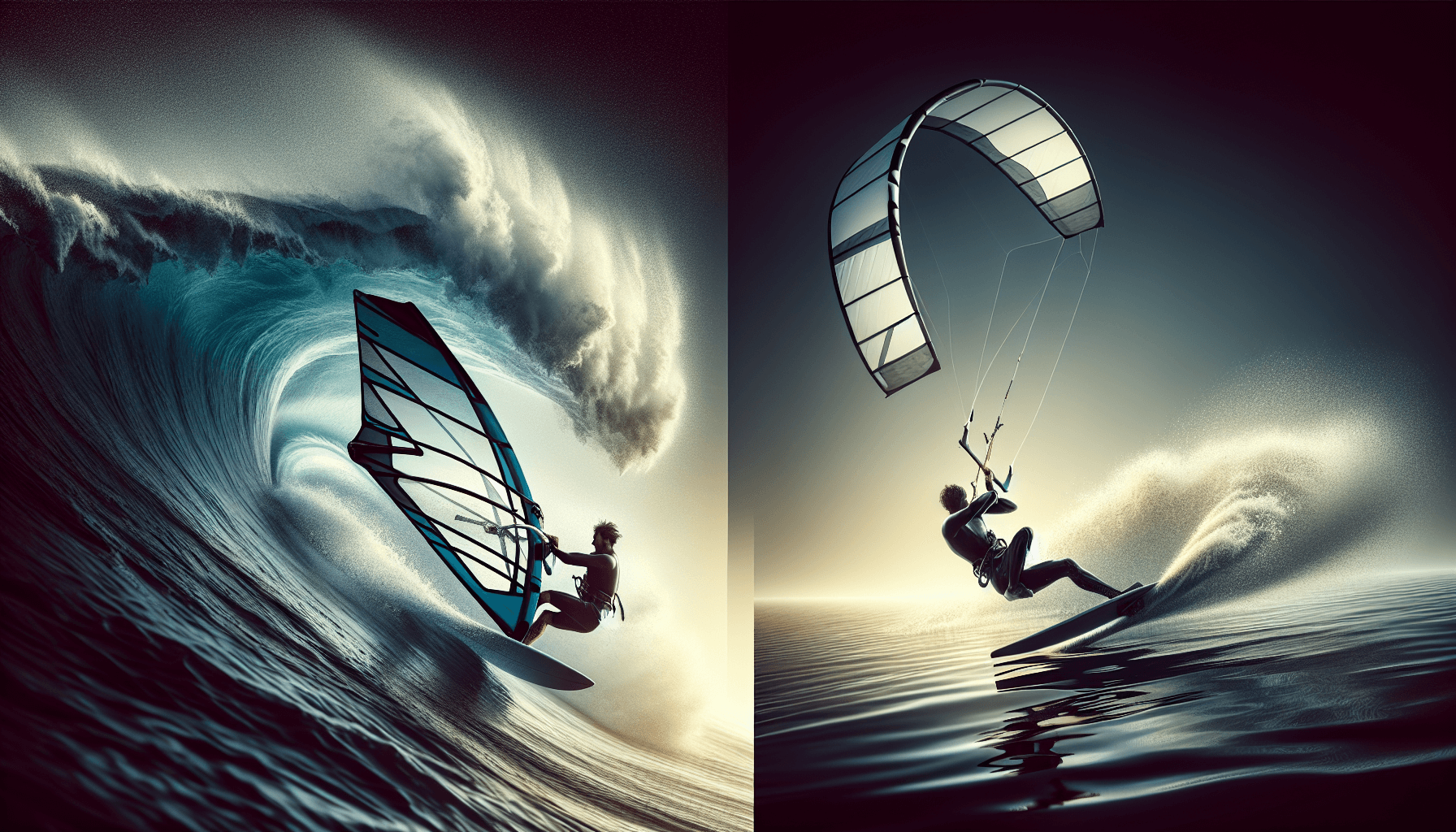
Like the gear and experiences, the learning process varies between sports, such as windsurfing and kitesurfing. Each sport comes with unique challenges and milestones, which can make the journey from beginner to pro a very different experience.
Kitesurfing beginners need to spend a few hours on the beach learning to handle the kite before riding on the water. But once they get the hang of it, they often progress rapidly to basic riding techniques. Kitesurfers can achieve riding speeds and techniques in roughly 20 hours of practice, which would take windsurfers about two years to learn.
In contrast, windsurfing offers a more gradual learning curve. Students progress steadily, with significant improvement attainable through private lessons, including video analysis. From mastering the basics to navigating complex maneuvers, the journey to becoming an experienced windsurfer is a continuous learning and skill development process.
From Beginner to Expert: Windsurfing’s Gradual Mastery
The journey from beginner to expert in windsurfing is a gradual one. New windsurfers start with lessons on the sport’s fundamentals, such as equipment knowledge, motion sequences, and basic terms, followed by their first on-water experiences. This initial phase empowers students to maneuver their board independently with guided supervision, advancing to skills such as cruising and returning to the point of origin solo.
Subsequent beginner course lessons cover increasingly challenging maneuvers like jibing, beach starts, adapting to more extensive and bigger sails, and higher wind speeds. At the expert level, windsurfers continue developing through tailored courses that include sophisticated techniques, from complex beach and water starts to high-level freestyle maneuvers.
The progression in windsurfing may be slower than kitesurfing, but it provides a deep sense of accomplishment with each new skill mastered. This gradual mastery allows a thorough understanding of the sport, from controlling the sail to navigating the waves.
Quick to Plane: Kitesurfing’s Rapid Progression
Kitesurfing offers a different learning curve. Beginners quickly learn water body dragging and are taught how to put the board on their feet for a water start. Progression is fast, and the thrill of kitesurfing can be experienced relatively quickly. Staying upwind is a significant milestone in kitesurfing, requiring additional practice after mastering the basics under instruction.
But the learning doesn’t stop once you’ve got the basics down. Developing intermediate skills such as toeside riding and slalom turns is essential for more straightforward kitesurfing progression beyond the primary level.
As experience increases, advanced skills, including back rolls and kiting in strong winds with smaller kites, are natural progressions. High-level kitesurfing entails mastering complex maneuvers like mega loops and handle passes, requiring significant skill progression.
Though kitesurfing’s learning curve may be steep, the reward is immediate and thrilling. With the correct instruction and practice, you’ll soon find yourself skimming across the water’s surface and even catching some air!
Physicality and Fitness: Windsurfing vs Kitesurfing
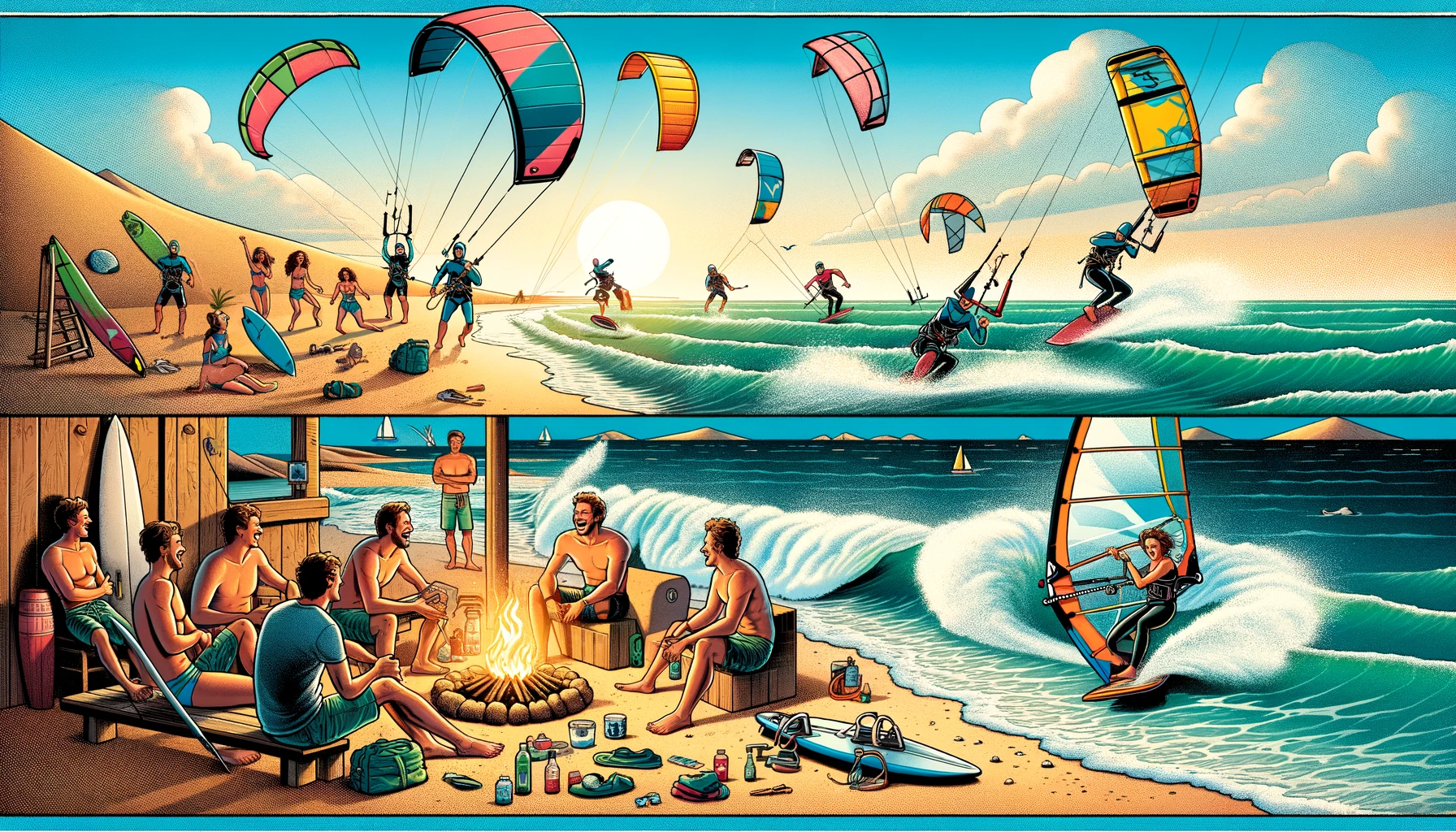
Beyond the wind, water, and speed thrills, windsurfing and kitesurfing offer a fantastic workout. But the physical demands and fitness requirements of each sport are quite different.
Windsurfing, a physically demanding sport, necessitates increasing stamina with each session. It provides a full-body workout, requiring the engagement of:
- Forearms
- Core body
- Upper back
- Lower back
- Quadriceps
- Hamstrings
Maintaining tension to convert the wind’s power into forward motion is critical, underscoring the importance of endurance and physical effort.
Conversely, while kitesurfing is generally less physically intense, it demands a robust core for stability and kite power control, particularly during maneuvers or tricks. Whether you’re a fitness enthusiast looking for a new challenge or someone just starting your fitness journey, both sports offer a fantastic way to stay active and healthy while having fun.
Muscle Power: Windsurfing’s Upper Body Strength
Windsurfing requires significant strength in various parts of the body. Here are some exercises that can help improve your windsurfing performance:
- Forearm exercises are essential for gripping the boom and controlling the sail. Try exercises like wrist curls and forearm curls.
- Core exercises: Core strength is crucial for transferring sail power to the board. Planks and Russian twists are great exercises for strengthening your core.
- Upper back exercises: Strong upper back muscles are essential for sheeting in with the sail and maintaining good posture. Rowing, pull-ups, and lat pulldowns are practical exercises for strengthening the upper back.
- Lower back exercises: An intense lower back is essential for maintaining good posture and stability. Romanian deadlifts and back extensions can help strengthen the lower back.
Incorporating these exercises into your fitness routine can help improve your windsurfing performance by increasing your strength and stability.
Leg muscles, specifically the quadriceps and hamstrings, play a continuous role in keeping the board level and transmitting sail power, with squats and lunges being effective training exercises. So, while riding the waves, remember you’re having fun and getting a fantastic full-body workout!
Harnessing Control: Kitesurfing’s Waist Harness and Core Engagement
In kitesurfing, the waist harness fits around the abdomen, allowing for entire leg movement and more excellent torso maneuverability, which is crucial for control and balance. This setup demands strong core muscles to maintain stability and control the kite’s power, especially when maneuvering or performing tricks.
A waist harness requires the kitesurfer to have a well-developed core to resist the kite’s pull and facilitate agile movement on the water. So, while kitesurfing may not have the same physical demands as windsurfing, it still requires a good fitness level, particularly in the core.
But don’t worry if you’re not quite there yet; just like any sport, the more you practice, the stronger you’ll get!
Environmental and Location Considerations
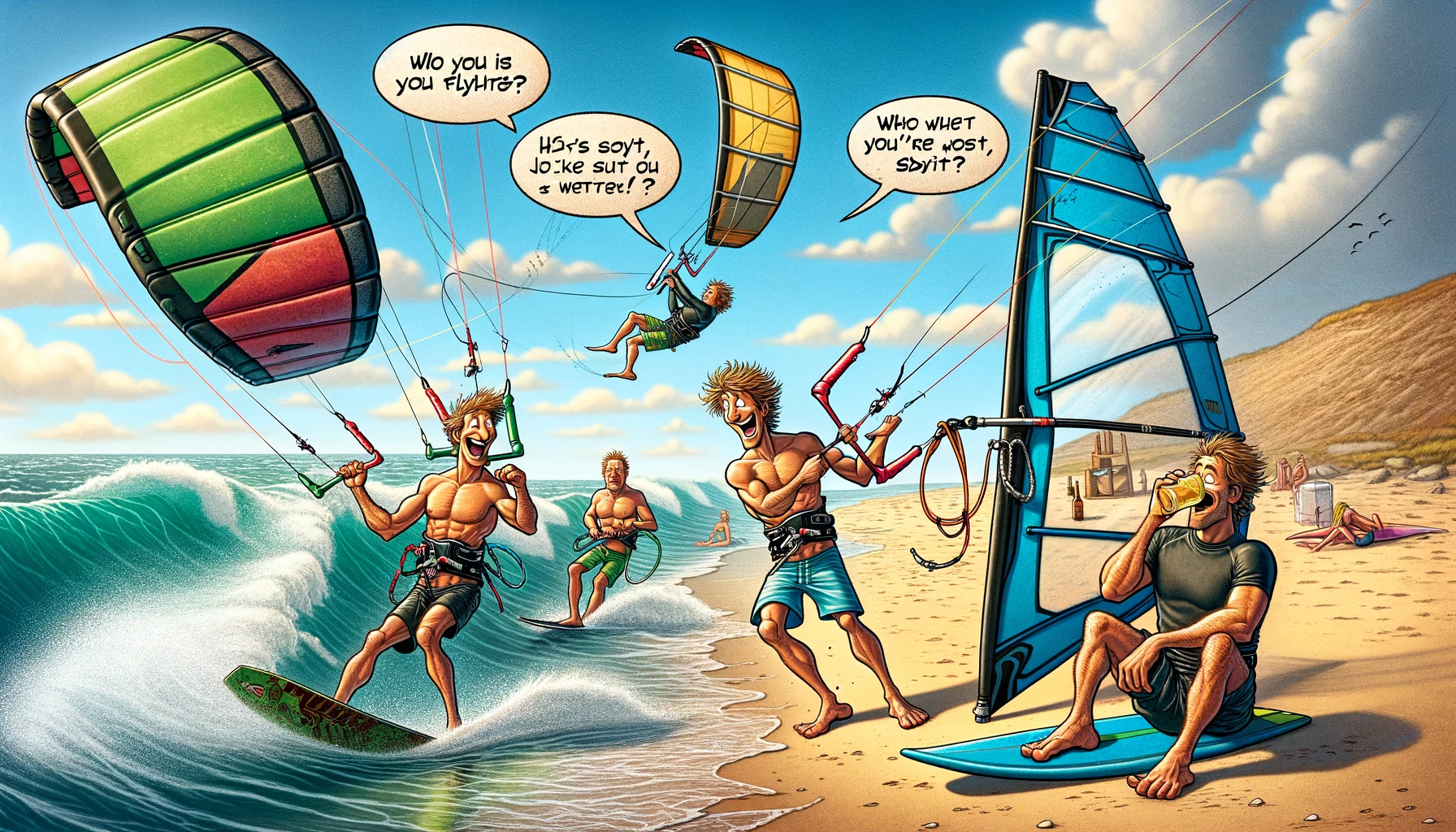
The environment and location are critical considerations, whether you’re windsurfing or kitesurfing. Both sports can be practiced in versatile aquatic environments such as rivers, lakes, or seas. However, the operational and safety considerations for accidents in kitesurfing take into account a range of up to 200 meters downwind, whereas windsurfing concerns extend only 5-20 meters around the surfer.
Some locations may be more conducive to one sport over the other. For example:
- Locations with steady winds and flat water are ideal for windsurfing
- Places with consistent wind and wave conditions are perfect for kitesurfing
- The location’s geography can also be a factor, with shallow waters being more favorable for kitesurfing.
The location of your practice is an essential factor when choosing your sport. Do you have access to a location suitable for windsurfing or kitesurfing?
Are your area’s wind and water conditions favorable for one sport over the other? These are all factors to consider when deciding between windsurfing and kitesurfing.
Wind Conditions: Light Winds vs Strong Winds
Wind conditions are a vital factor in both windsurfing and kitesurfing. After all, no wind means no ride! However, the ideal wind conditions can vary between the two sports.
Kitesurfing generally requires effective winds of at least 11 knots and is ideal in 15 to 25 knots or stronger winds. In lighter winds that are insufficient for windsurfing with larger sails, kitesurfing can still offer a thrilling experience due to its ability to plane effortlessly.
On the other hand, advanced windsurfers find wind-speed between 17-25 knots optimal for high-speed maneuvers and jumps. In comparison, winds above 25 knots increase the level of risk and are only advisable for very experienced windsurfers. So whether you prefer light breezes or strong gusts, both sports offer a way to harness the wind’s power and hit the waves!
Water Terrain: Choppy Conditions vs Shallow Water
Like wind conditions, water terrain can influence your windsurfing or kitesurfing experience. Here are some types of water terrain that can significantly impact your ride:
- Shallow lagoons
- Choppy seas
- Flat water
- Waves
- Currents
In windsurfing, the water’s condition plays a significant role in the ride. Choppy conditions can make windsurfing more challenging but also more thrilling, as the waves offer extra opportunities for jumps and tricks. On the other hand, flat water conditions can be perfect for speed trials and smooth cruising.
For kitesurfing, the water terrain is less of an issue. Kitesurfing is less impacted by shallow water than windsurfing because the rider skims the surface and doesn’t have to worry about a fin hitting the seabed. Whether riding in shallow water or deep sea, kitesurfing offers an adrenaline-pumping ride.
Safety on the Seas: Risk Assessment of Extreme Sports
As with any extreme sport, windsurfing and kitesurfing carry their unique risks. But don’t let that deter you. With suitable precautions, both sports can be enjoyed safely.
Kitesurfing has a higher rate of accidents and more severe consequences than windsurfing. This is due mainly to the immense power generated by the kite, which can be a hazard if not managed correctly. However, modern kitesurfing gear has advanced safety features, such as depower systems and quick releases, to enhance safety.
Windsurfing, on the other hand, is generally considered safer, but it also has risks, such as the potential for catapults if the fin strikes the ground while speeding. To avoid collisions and accidents, windsurfers must be aware of their surroundings, especially during high-speed maneuvers.
No matter the sport you choose, safety should always be your priority. Wear the proper gear, be aware of your surroundings, and never exceed your skill level.

Mitigating Dangers: Kitesurfing’s Safety Features
Kitesurfing’s safety features are designed to mitigate potential dangers. Modern kitesurfing bars have advanced safety features, including depower systems and one-handed quick releases. These features allow kitesurfers to release most of the kite’s power in various wind conditions, providing an added layer of safety.
The front re-ride system is a critical 4-line bar safety feature that depowers the kite when necessary by allowing the bar to slide towards the kite along a safety line. Additional safety features, like the ‘stopper ball,’ prevent the bar from sliding to the kite during self-rescue maneuvers, providing an extra safety measure.
However, these safety features are only as effective as the rider’s ability. Comprehensive safety training, including lessons that cover:
- kite setup
- rigging
- launching
- the use of safety releases
It is vital for all kitesurfers. By understanding and correctly using these safety features, kitesurfers can enjoy the thrill of the sport with peace of mind.
Self-Reliance at Sea: Windsurfing’s Independent Nature
In contrast to kitesurfing’s reliance on safety features, windsurfing emphasizes self-reliance. Using reliable and high-quality equipment is a crucial safety measure to ensure a safe experience on the water. Windsurfers should wear appropriate attire, such as a wetsuit to protect against hypothermia and other dangers, and a buoyancy aid like a USCG life vest or jacket with an attached whistle.
Windsurfing after dark is discouraged due to limited visibility and increased risk of being unaware of surroundings, which can lead to accidents. Knowing water traffic rules, such as the right of way on starboard tack over port tack and keeping a distance of at least one mast length when overtaking, can help prevent collisions and accidents.
Checking the weather before heading out is crucial for windsurfing safely, as conditions can change rapidly, and adverse weather can increase the risks. It is also advised not to windsurf alone in case of equipment failure or injury, as being swept off course without a companion can be extremely dangerous.
Overall, while windsurfing may not have as many built-in safety features as kitesurfing, the emphasis on self-reliance and proper preparation helps ensure a safe experience on the water.
Accessibility and Transport: Getting Your Gear to the Water
Whether you opt for windsurfing or kitesurfing, transporting your gear to the water is necessary. The equipment used in both sports is quite large, and transporting it requires careful planning and the right vehicle.
Due to their length and weight, transport vehicles like SUVs and trucks equipped with roof racks are typically necessary to transport windsurfing equipment. The size of the mast foot of the windsurfing sail must also be considered when selecting transportation methods, as larger sails require more space and careful handling.
On the other hand, kitesurfing gear is a more compact enough wind well, allowing it to often fit inside a car and reducing the need for additional transport equipment like roof racks. So whether you’re packing up for a day at the local beach or planning a windsurfing or kitesurfing vacation, it’s essential to consider how you’ll transport your gear.
Portability Pros and Cons: Kite Gear vs Windsurf Kit
Regarding portability, there are pros and cons to both windsurfing and kitesurfing gear. Windsurfing equipment is quite large, and transporting it can be a challenge. The boards and masts can be too long for smaller vehicles, requiring a large car or additional transport accessories like extendable racks.
Furthermore, the available space in a parking lot or lots can be a limiting factor in the assembly of windsurfing gear, with the process generally requiring more area than kitesurfing.
On the other hand, kiteboarding equipment is generally more portable. The gear is smaller and lighter, and kiteboarders can conveniently transport it, carrying the board under their arm and kite over each shoulder or within a single bag.
But regardless of the sport, advancements in gear design are making equipment more portable. From foldable kitesurfing boards to inflatable windsurfing rigs, these innovations make it easier to take your gear.
On-the-Go Solutions: Inflatable and Compact Options
For those prioritizing portability, inflatable and compact options are available for windsurfing and kitesurfing equipment. These options are designed to be easy to transport and store, making them an excellent choice for those who travel frequently or have limited storage space.
For kitesurfers, foldable boards are a space-saving innovation, providing an easy transportation option, particularly beneficial for air travel. In windsurfing, the Duotone iRig One is revolutionizing the sport with its inflatable design, offering an ultra-compact and user-friendly solution for beginners prioritizing portability.
Other compact windsurfing rigs like the STX Evolve, RRD Compact Freeride, Compact Vogue HD Y26, and entry-level options from Starboard accommodate the traveler’s need for portability by fitting into travel bags that simplify transportation.
Whether you’re planning a windsurfing or kitesurfing trip overseas or need a compact solution for your weekend trips to the beach, these inflatable and compact options can make getting your gear to the water a breeze.
Summary
In the end, windsurfing and kitesurfing offer thrilling ways to ride the wind and waves. Whether you prefer the tactile experience of carving through waves with a windsurfing board or the airborne thrills of kitesurfing, there’s a water sport out there for you.
The choice between windsurfing and kitesurfing will depend on your preferences, physical fitness, and the conditions in your local area. But whichever sport you choose, you will find an exhilarating experience that connects you with nature, provides a great workout, and offers a thrilling ride. So why wait? Dive in and start your windsurfing or kitesurfing journey today!
Frequently Asked Questions
Which is more accessible, windsurfing or kiteboarding?
Kiteboarding is generally considered easier than windsurfing due to putting less strain on the body. Windsurfing demands more physical stamina and provides a more significant challenge.
What are the disadvantages of kitesurfing?
Kitesurfing can be physically challenging due to its reliance on specific weather conditions, particularly the need for consistent wind. Additionally, adapting to changing weather conditions is essential for safe practice.
What is the difference between windsurfing and kite surfing?
The significant difference between windsurfing and kitesurfing is that you are attached to both the board and the sail, whereas in windsurfing, the sail is connected to the board and not to you. This means that if you fall during your voyage, you fall off.
What are the ideal wind conditions for windsurfing and kitesurfing?
The ideal wind conditions for kitesurfing are generally at least 11 knots, while advanced windsurfers prefer wind speeds between 17-25 knots. So, for a great experience, aim for these wind speeds.
How do I transport my windsurfing or kitesurfing gear?
You may need a larger vehicle or roof racks for windsurfing gear, as they are usually significant. On the other hand, Kitesurfing gear is more compact and can often fit inside a car. Consider inflatable or compact options for more accessible transport and storage.



